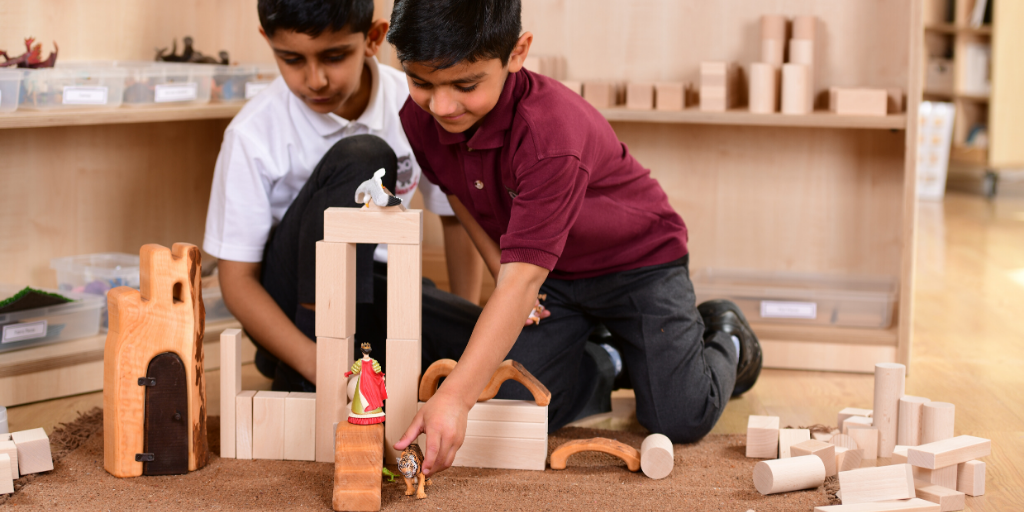Whether you’re setting up your new classroom for the first time, or changing your existing layout, it is vitally important to get it right. The actions you take and the decisions that you make at this point in the year can have a massive impact for you and your children. Get it right and you’ll be encouraging the development of a whole range of skills and concepts and, even more than that, you’ll create positive attitudes around the whole idea of learning and finding out new things. No pressure then! Below are a few ideas that will help.
This article is also available as a podcast:
Ideas For Setting Up Your New Classroom:
1. Use shelving to create clearly defined areas of provision.
Children will be more highly involved and engaged in an area of your classroom if the spaces are clearly defined. This definition should provide enough height so that children can become engrossed in carrying out their own ideas without being easily distracted. Whilst creating this definition, think about the spaces that you’re providing, is there enough space for the activity? Are you limiting the possibilities of what the children will do by the amount of space? Which areas of the room are you using for the provision and what does this indicate about your practice? Tables placed in the middle of a room without a clear purpose often have a negative impact on the use of provision areas and the quality of interactions too.
2. Think carefully about the layout of your classroom
In order to get the most out of your space, the links between some areas should be clear. For example, your paint easel is best placed within or adjacent to your workshop area. Here children will have access to a huge range of creative possibilities- printing with bottle tops, adding patterns and different materials. The children might also make a box model in this area and then paint it at the easel. Exciting stuff!
Create a home corner role play area rich with possibilities for playing roles that the children will be familiar with – can your children put a wash on, hang it out to dry, iron, feed and bath the baby, cook and clean? Alongside this, provide realistic purposes for writing that will naturally come from their ideas- birthday invites, shopping lists, labels and birthday cards. As you consider this, it makes sense to locate the mark making area close by. This encourages children to move easily between the two spaces easily, carrying out purposeful and imaginative mark making ideas.
3. Make sure that the storage of your resources encourages independent thoughts and actions.
The most effective spaces encourage the children to form their own ideas and then carry them out independently. Independence of thought and action are a key part of the learning process and are crucial motivating factors too. How resources are stored for the children to access can have a big impact on this process. Can your children easily access resources in the areas that you have created? Children will be much more likely to use what they can easily see and get their hands into. Resources should be stored in separate boxes or baskets which are clearly labelled. The motivation to carry out an activity can very easily be lost if access is an issue: a child with a clear idea for building will be soon put off if they have to tip up a big box of construction to find the one piece they need!
4. Do your resources earn their place on the shelf?
Set out a rich set of resources which will offer a wide variety of possibilities. This is your continuous provision and should be available to the children every day throughout the year. These are your teaching tools and the decisions that you make around the resourcing of the areas of provision in your classroom are crucial to its success. So, when you place things on shelves for the children to use, make sure that you know what each resource offers, what will the children be likely to do with it and is it the best resource you can offer? You don’t need to provide large quantities of the same resource- ten almost identical buckets for example. Instead, think about variety and richness and depth of thinking: do you have a clear bucket, one with measured markers, buckets of different sizes and shapes? Will all your children find something in their classroom that fascinates and engages them, that connects with their prior experiences and current fascinations. Will the resources in your room prompt your children to tell you something about themselves and what really matters to them?
And there you go, four steps to get you started. There’s lots to think about but keep to the principles outlined here and you won’t go far wrong. If you need support with your provision, we’re always happy to help.
Take a look at the complete classroom solutions curated for each age group, find out about our bespoke design service for help with planning your space and browse our online resource shop to make individual selections.
Invest in your professional development with our Continuous Provision Guides, packed with practical information to help plan and resource your EYFS and KS1 learning environments.

